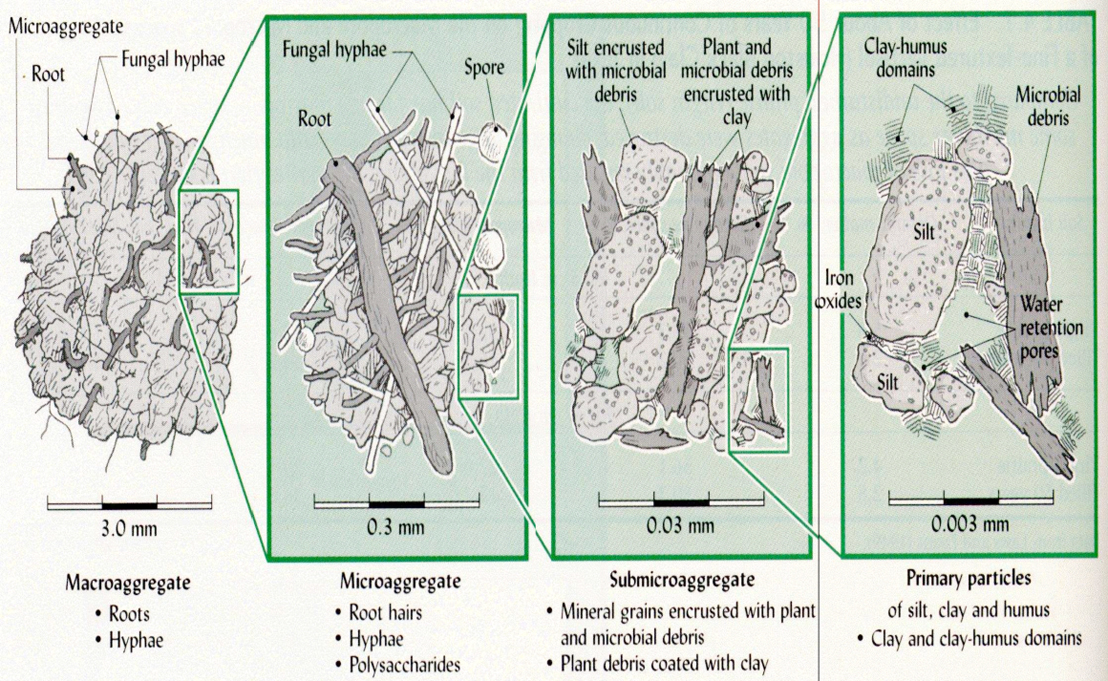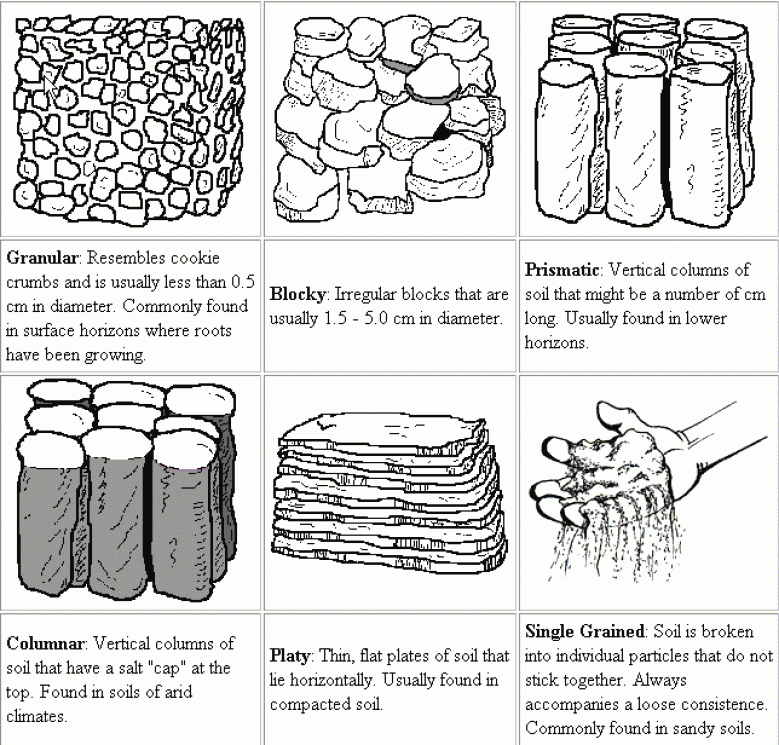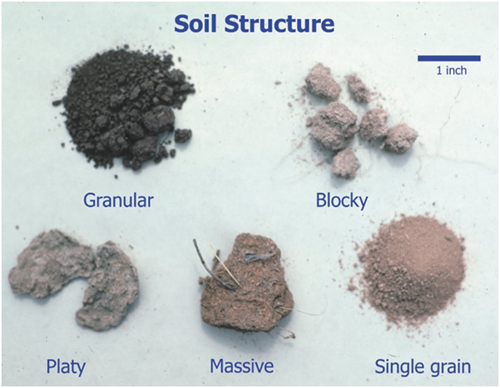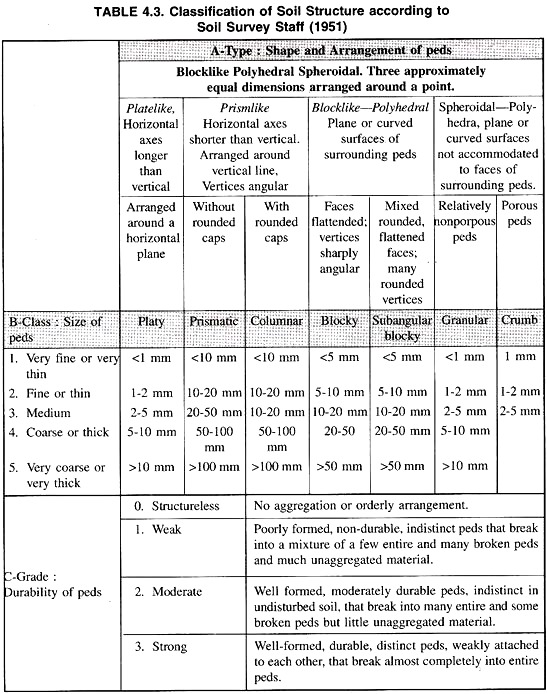Soil Structures
Soil Structure
Soil structure refers to an arrangement or groups of particles. These arrangements can be composed of any size particles ranging from nonstructural such as loose, coarse grains, to aggregates such as chunks of sod (5). Soil structures also encompass the pore space between soil particles. Soil structure is achieved when soil particles experience cohesion forces that are greater than adhesion. Cohesion forces allow soil particles to clump, bind, and aggregate. Stabilization is achieved through bonding agents such as plant, microbial polysaccharides, and gums (5). Roots and Fungal Hyphae such as mycorrhizal fungi can act as bonding agents. Some soils have a lack of structure; this occurs when no particles stay in place with an introduction of a disturbance such as a shovel blade (7). Soil structure influences ecosystem properties such as water retention, soil water movement, erosion, nutrient recycling, root penetration, and crop yield (2).
Soil structure can be observed as a soil mass when, under stress, it breaks along planes. These planes form the boundary of structural units called a “ped”, which have different spatial soil particle arrangements (7). Clods are formed through artificial human caused disturbances such as a mechanical disturbance (tilling a field). Such disturbances allow denser particles to be configured to the surface in the layer (7). One soil may have various peds based on shape in the subsurface and surface horizons (5). Peds are shaped by temperature, moisture, chemical, and biological conditions. Each of these conditions may vary depending on the level in the soil horizon (5). The Pedon is the area of soil structure being categorized. It can be as small as 1 square meter or as large as 10 square meters (5).
Soil Structure Formation
Soil structure is shaped by the input of organic compounds into the soil, plants, fungi, microbes, soil compaction, freezing-thawing, wetting, and drying events (5). Aggregates are the physical and biological compounds in which soil particles coheir to. Aggregation can be increased through root activity. Roots release Polygalacturonic Acid which acts to stabilize aggregates through a higher bond strength and a slower wetting rate (2). The more fibrous a root is, the more macro-aggregation that will occur within the rhizosphere (2). One of the most important biotic influences on aggregates is AMF or Arbuscular Mycorrhiza through the release of Glomalin, a glycoprotein which acts to stabilize aggregates (2).
 Figure 1 Soil Microaggregates. Note the influence of root fibers, hyphae, and microbial debris. Image From Tisdall & Oades, 1982 (10)
Figure 1 Soil Microaggregates. Note the influence of root fibers, hyphae, and microbial debris. Image From Tisdall & Oades, 1982 (10)
Classification
Soil structures can be classified by their size, structure, shape, and grade
 Figure 2: The various soil structure types. (2)
Figure 2: The various soil structure types. (2)
 Figure 3: Soil structure types looking at soil samples (9)
Figure 3: Soil structure types looking at soil samples (9)
Soil Grade:
Grade referrers to the distinctness of soils. Three classes are chosen based on ese of separation into specific units and the particles ability to stick together.
Strong: Soil units separating cleanly into whole units with disturbance.
Moderate: Soil units are noticed as well formed pre disturbance. Post disturbance, soil will separate into a mixture of primarily whole units, broken units and some material not in a unit
Weak: Soil units, when disturbed, are mostly not in units while some stay in units. Most soil particles will show no planes of weakness. If the soil surface arrangement differs from the particles within, this is still a soil structure compared to a uniform consistency showing no planes of weakness which is most likely a structure less soil sample. (7)
Figure 4: A soil structure classification table incorporating Shape/arrangement, structure class, and grade. (8)
References
1: "BlackHillsGarden.com." SOIL STRUCTURE. » BlackHillsGarden.com - Gardening Experience in the Black Hills, 2018. Web. 08 Mar. 2018.
2: Bronick, C.J., and R. La. "Soil Structure and Management: A Review." Shibboleth Authentication Request. The Ohio State University, Jan. 2005. Web. 07 Mar. 2018.
3:Buckman, H. O., & Brady, N. C. (1960). The nature and properties of soils: A college text of edaphology. New York: Macmillan.
4: Cakmak, A. S. Soil-structure Interaction. Vol. 43;43.;. New York;Southampton;Amsterdam;Boston;: Elsevier, 1987. Web. 6 Mar. 2018.
5: Coleman, D. C., D., A. C. J., & Hendrix, P. F. (2004). Fundamentals of soil ecology. Retrieved from https://ebookcentral.proquest.com
6: Gao W, Hodgkinson L, Jin K, Watts CW, Ashton RW, Shen J, Ren T, Dodd IC, Binley A, Phillips AL, Hedden P, Hawkesford MJ, Whalley WR (2016a) Deep
roots and soil structure. Plant Cell Environ 39:1662–1668
7:"Natural Resources Conservation Service." SSM - Ch. 3. Examination and Description of Soil Profiles | NRCS Soils. N.p., n.d. Web. 08 Mar. 2018.
8:"Soil Structure: Classification, Genesis and Evaluation." Soil Management. N.p., 20 July 2016. Web. 08 Mar. 2018.
9:"Soil Structure | Nature of Soil | Soil Definition | Components of Soil." ENCYCLOPEDIA OF ENGINEERING. N.p., 25 Dec. 2017. Web. 8 Mar. 2018.
10:TISDALL, J. M., and J. M. OADES. "Organic Matter and Water‐stable Aggregates in Soils." Journal of Soil Science. Blackwell Publishing Ltd, 28 July 2006. Web. 08 Mar. 2018.
